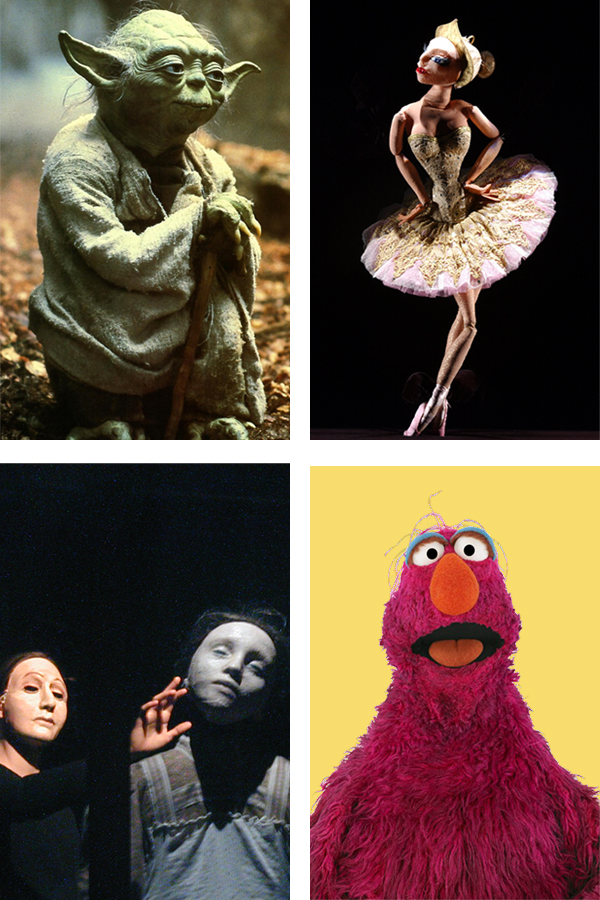2011 Philadelphia International Festival of the Arts
For thousands of years, puppeteers and their audiences have known what Hollywood still hasn't quite mastered: how to breathe life into the inanimate to create a consistent reality. Puppets have historically served as the middlemen between humanity and its gods, inviting viewers to reimagine the world long before motion pictures and computers did. As live theater and cinema battle for audience, what role does the puppet play on stage and on screen? While technology races forward, creating new ways of defining experience, one question sums up the issues: was the puppet Yoda in the original Star Wars saga better than his digital representation in the later movies?
Join us for a a romp through the world of puppetry old and new, using video and live performances in this roundtable discussion featuring reflections, anecdotes, and analysis from some of the world’s most notable scholars and practitioners of puppetry. On hand will several of Martin Robinson's puppet creations, antique and modern.
One of the foremost puppet artists in the United States, Robert Smythe has been called an "amazing amalgam of man and puppet." As founder and Artistic Director of Mum Puppettheatre, the only regional theater in the U.S. devoted to puppetry during its 23-year run, he has written, directed, and performed over 20 original productions using puppets, masks, and human actors. According to the Philadelphia City Paper, his work helped to spark a "Philadelphia theater renaissance that continues to this day," and has had a nationwide impact on public perceptions of both puppetry and theater.
Smythe has won fellowships from the National Endowment for the Arts, the Guggenheim Foundation, and the Pew Charitable Trusts, as well as awards and honors from the Pennsylvania Council on the Arts and the American Center for the Union Internationale de la Marionnette. He has won four Barrymore Awards in the areas of choreography, design, and education, and received Barrymore nominations for acting and sound design.
He has directed and created work for the Arden Theater, the Wilma Theater, Interact Theater Company, the Children's Theater Company in Minneapolis, and the Independent Eye. He has created four original concert works with the Philadelphia Orchestra and one of them, Swan Lake, won the 2003 Barrymore Award for Outstanding Collaboration. He is currently directing Stravinsky's L'Histoire du Soldat (The Soldier's Tale) as part of the 2011 Philadelphia International Festival of the Arts at the Kimmel Center.
Smythe was the first American theater artist to visit Romania after the fall of the Communist government there. He has performed his work throughout Japan, Europe, North and Central America, and at many venues throughout the United States, including the John F. Kennedy Center for the Performing Arts and the Baltimore Theater Project. His work can also be seen at EPCOT Center at Walt Disney World and on Nickelodeon.
Martin P. Robinson has been a professional puppeteer since discovering it as the perfect link between acting and sculpture. A graduate of the American Academy of Dramatic Arts, he has worked for Nicolo Marionettes, Addis Williams, Bob Brown, Paul Ashley, Bil Baird, and Jim Henson, as well as spending five seasons with the British TV show "Spitting Image."
As a puppeteer on Sesame Street since 1981, he has performed Snuffleupagus, Telly Monster, Slimey the Worm, and those "Yip-yip" Martians. During his spare time, he performed the Cat in the Hat on the Nickelodeon series The Wubbulous World of Dr. Seuss.
His company, Hairy Edge Productions, has designed and performed Allegra's Window and Blue's Room on Nickelodeon and Oobi on Noggin. As the senior puppet coordinator for Sesame International, he also teaches, hiring and training puppeteers for productions in Canada, Mexico, Israel/Palestine, Egypt, Germany, Russia, Bangladesh, France, India, Indonesia, Northern Ireland, and China.
Film credits include Follow That Bird, Muppets Take Manhattan, Elmo in Grouchland, Teenage Mutant Ninja Turtles, and The Producers. In 1982, Martin designed, built, and performed the plant in the original Off-Broadway production of Little Shop of Horrors, for which he received a Drama Desk and an LA Drama Critics Award. He provided the same services for the incarnation of the show that was on Broadway in 2004. He also designed for the production of Frogs at Lincoln Center, and two productions with orchestra for Carnegie Hall.
Eileen Blumenthal is Professor of Theatre Arts at Mason Gross School of the Arts, Rutgers University, and writer on contemporary Asian and Western theater. She has written hundreds of articles and reviews as a regular contributor to the Village Voice and Soho Weekly News, and her articles have appeared in the New York Times, the Washington Post, the Wall Street Journal, American Theatre, Asian Theatre Journal, Theater, Natural History, and Cultural Survival.
Blumenthal is also the author of Puppetry: A World History and Joseph Chaikin: Exploring at the Boundaries of Theatre, and coauthor of Julie Taymor: Playing with Fire.
Her awards include Woodrow Wilson, Kent (Danforth), and Guggenheim Fellowships; an Asian Cultural Council Grant; a National Endowment for the Humanities Fellowship for University Teachers; a Rockefeller Foundation Bellagio Residency; a Camargo Foundation residency in Cassis; the USITT (U.S. Association of Theater Designers and Technicians) Golden Penä Award, and the George Jean Nathan Award for her writings on Cambodian Dance.
Ms. Blumenthal holds a B.A. and an M.A. in English and American Literature from Brown University and a Ph.D. from Yale. She has consulted on film and public television performing arts projects, university theatre and dance programs, the National Endowment for the Arts, the National Endowment for the Humanities, and private foundations, and she has lectured and served on panels for universities and public arts programs.
Puppets: The Original Avatars
April 13, 2011 (Wednesday) / 5:00 pm—6:30 pm
Bodek Lounge, Houston Hall, 3417 Spruce Street




